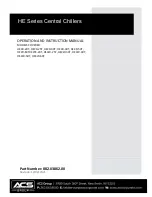
SECTION I : USER
22
I.6
WARNINGS REGARDING POTENTIALLY TOXIC
SUBSTANCES
DANGER!
Read the following information about the
refrigerants employed carefully.
I.6.1.1
Identification of the type of refrigerant fluid
used
Difluorometano (HFC 32) 50% in weight
N° CAS: 000075-10-5
Pentafluoroetano (HFC 125) 50% in weight
N° CAS: 000354-33-6
I.6.1.2 Identification
of
the type of oil used
The lubricant used in the unit is polyester oil; please refer to the
indications on the compressor data plate.
DANGER!
For further information regarding the
characteristics of the refrigerant and oil used, refer
to the safety data sheets available from the
refrigerant and oil manufacturers.
I.6.1.3
Main ecological information regarding the
types of refrigerant fluids used
Persistence, degradation and environmental impact.
Fluid
Chemical formula
GWP (over 100 years)
R32
CH
2
F
2
550
R125
C
2
HF
5
3400
HFC R32 and R125 refrigerants are the single components which
mixed at 50% make up R410A. They belong to the hydrofluorocarbons
group and are regulated by the Kyoto protocol (1997 and subsequent
revisions) being gases that contribute to the greenhouse effect. The
index which measures how much a certain mass of greenhouse gas
contributes to global warming is the GWP (Global Warming Potential).
The standard measure for carbon dioxide (CO2) is GWP=1.
The value of GWP assigned to each refrigerant represents the
equivalent amount in kg of CO2 released over a period of 100 years, in
order to have the same greenhouse effect of 1kg refrigerant released
over the same period of time.
The R410A mixture does not contain elements that are harmful to the
ozone layer, such as chlorine;, therefore, its ODP (Ozone Depletion
Potential) is zero (ODP=0).
Refrigerant
R410A
Components
R32/R125
Composition
50/50
ODP
0
GWP (over 100 years)
2000
SAFEGUARD THE ENVIRONMENT!
The hydrofluorocarbons contained in the unit
cannot be released into the atmosphere as they are
gases that contribute to the greenhouse effect.
R32 and R125 are hydrocarbons which decompose rapidly into the
lower atmosphere (troposphere). Decomposition by-products are highly
dispersible and thus have a very low concentration. They do not affect
photochemical smog (that is, they are not classified among VOC volatile
organic compounds, according to the guidelines established by the
UNECE agreement).
Effects on effluent treatment
Waste products released into the atmosphere do not cause long-term
water contamination.
Personal protection/exposure control
Use protective clothing and gloves; protect eyes and face.
Professional exposure limits:
R410A
HFC 32
TWA 1000 ppm
HFC 125
TWA 1000 ppm
Handling
DANGER!
Users and maintenance personnel must be
adequately informed about the risks of handling
potentially toxic substances. Failure to observe the
aforesaid indications may cause personal injury or
damage the unit.
Avoid inhalation of high concentrations of vapour. The atmospheric
concentration must be reduced as far as possible and maintained at this
minimum level, below professional exposure limits. The vapours are
heavier than air, and thus hazardous concentrations may form close to
the floor, where overall ventilation may be poor. In this case, ensure
adequate ventilation. Avoid contact with naked flames and hot surfaces,
which could lead to the formation of irritant and toxic decomposition by-
products. Do not allow the liquid to come into contact with eyes or skin.
Procedures in case of accidental refrigerant leakage
Ensure adequate personal protection (using means of respiratory
protection) during clean-up operations. If the conditions are sufficiently
safe, isolate the source of leak.
If the extent of the spill is limited, let the material evaporate, as long as
adequate ventilation can be ensured. If the spill is considerable,
ventilate the area adequately.
Contain the spilt material with sand, soil, or other suitable absorbent
material.
Prevent the liquid from entering drains, sewers, underground facilities or
manholes, because suffocating vapours may form.
I.6.1.4
Main toxicological information on the type
of refrigerant used
Inhalation
A high atmospheric concentration can cause anaesthetic effects with
possible loss of consciousness. Prolonged exposure may lead to an
irregular heartbeat and cause sudden death.
Higher concentrations may cause asphyxia due to the reduced oxygen
content in the atmosphere.
Contact with skin
Splashes of nebulised liquid can produce frostbite. Probably not
hazardous if absorbed through the skin. Repeated or prolonged contact
may remove the skin's natural oils, with consequent dryness, cracking
and dermatitis.
Contact with eyes
Splashes of liquid may cause frostbite.
Ingestion
While highly improbable, may produce frostbite.
I.6.1.5
First aid measures
Inhalation
Move the person away from the source of exposure, keep him/her warm
and let him/her rest. Administer oxygen if necessary. Attempt artificial
respiration if breathing has stopped or shows signs of stopping.
In the case of cardiac arrest carry out heart massage and seek
immediate medical assistance.
Contact with skin
In case of contact with skin, wash immediately with lukewarm water.
Thaw tissue using water. Remove contaminated clothing. Clothing may
stick to the skin in case of frostbite. If irritation, swelling or blisters
appear, seek medical assistance.
Contact with eyes
Rinse immediately using an eyewash or clean water, keeping eyelids
open, for at least ten minutes.
Seek medical assistance.
Ingestion
Do not induce vomiting. If the injured person is conscious, rinse his/her
mouth with water and make him/her drink 200-300 ml of water.
Seek immediate medical assistance.
Further medical treatment
Treat symptoms and carry out support therapy as indicated. Do not
administer adrenaline or similar sympathomimetic drugs following
exposure, due to the risk of cardiac arrhythmia.
Содержание TCCEY 114
Страница 3: ......
















































